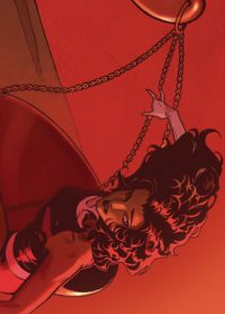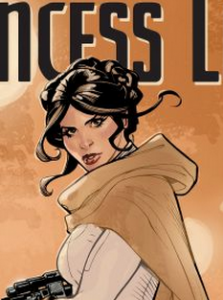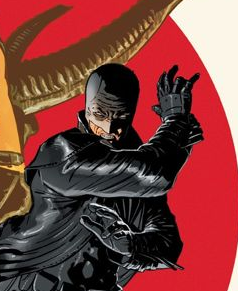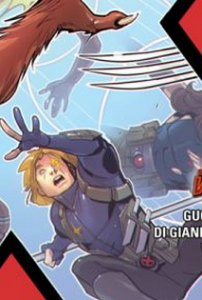Deadshirt Is Reading… is a weekly feature in which Deadshirt’s staff, contributing writers, and friends-of-the-site offer their thoughts on Big Two cape titles, creator-owned books, webcomics and more. For more of our thoughts on this week’s new comics, take a look at Wednesday’s Deadshirt Comics Shopping List.
Joe Stando is reading…
Written by Marguerite Bennett and G. Willow Wilson
Art by Jorge Molina (pencils) and Craig Yeung & Walden Wong (inks)
Colored by Laura Martin
Lettered by Cory Petit
Marvel
“Okay, guys…that was pretty cool.”
Probably because of the PR push behind it, A-Force #1 became something of a target among critics, with a number of reviews discussing not only whether it was a good comic, but whether it was a good jumping-on point for new readers, and also how nebulously “feminist” or “anti-feminist” it was. There were merits to some of these arguments, and I’m not against critical analysis by any means. But I’m glad the tempest in a teapot has died down by now, so we can look at A-Force as less of an end-all, be-all to superheroines, and more as an interesting new story.
I will admit that A-Force is a little hobbled by the Battleworld setting. A lot of books are running with the various domain ideas, with variant and alternate takes on characters rooted in the specific ideas behind the domains. A-Force, on the other hand, uses mostly core versions of the characters, in a configuration that seems more at home in the typical Marvel Universe than in one run by Doom. Molina, Yeung and Wong’s designs are stylish, but they’re classical in a way that sticks out in a “new” Secret Wars setting. This isn’t Bennett or Wilson’s fault, and it definitely seems written with the future ongoing in mind, but it’s sort of odd when we’ve gotten used to this weird world of Thors and barons. Telling a new, traditional story in Battleworld is sort of an anomaly.
But the story itself is great, I think! A broad mix of A-list and underused female characters, engaging in the kinds of conflicts that defined the best team book runs. Neither She-Hulk or Medusa are painted as cruel or dumb, and their clash of leadership styles doesn’t break down into a typical brawl. The team-based fight we do get is staged beautifully, and it’s really, REALLY nice to see a team prioritize protecting civilians over badass fighting moves (although we get a couple of those, too).
Interestingly, A-Force proves that even this “early” in Secret Wars, there’s a marked difference in feel between mainstream Marvel books and the current line. A-Force feels like a new “classic” story folded into this event, but for my money, it’s a story worth following.
Sarah Register is reading…
Written by Mark Waid
Art by Terry Dodson (pencils) and Rachel Dodson (inks)
Colored by Jordie Bellaire
Lettered by Joe Caramagna
Marvel
“Ma’am, they’ve been waiting for your return. Do you have a message I can pass on?”
“Just tell them—tell them—battle stations.”
After a disappointing first issue, I had a bad feeling about this. I was really rooting for this series to find its footing and, frankly, its purpose. Alas. On screen, Leia is a smart, capable woman who withstands torture and throws snark at her rescuers and enemies alike. But in her own solo comic, she comes off as naive, as her poor choices create a myriad of weak plotlines that make for less than riveting reading. That being said, this conclusion to the series was probably the strongest installment. Throughout the story, Leia has been chasing after the dream that is Alderaan, but it’s not until the final issue that the reader really understands what that dream means. In a moving speech to rally the troops, Leia emphasizes the importance of carrying on Alderaan’s values (wisdom, imagination, creativity, and hope). I wish that this culture had been in the forefront all along, because I think it was the readers that really needed a rally cry as the hero stumbled her way to some kind of victory.
The artwork continued to strike a good balance between drawing characters we first met on screen in the likeness of the actors while still stylizing them to match the rest of the comic. There were even some direct nods to the films here and there, like Leia, in her buns and hood, bending down to talk to Artoo. The heavy inks emphasized the lovely faces of Leia and Evaan in closeup, but all of the details seemed to get muddled every time there was a wide shot (which was often). However, even though the characters didn’t do well in the longer shots, the epic, though thankfully short-lived, space battle really shined in this issue with dazzling colors and explosions.
Despite Leia’s moving speech and the comic’s happy ending, I’m left feeling frustrated. I was stoked when Marvel honored Leia with her own title, but by the end I was so distracted by odd (or perhaps lazy) writing choices that I’m left wondering how much thought was really put into the story. Some of this stemmed from Evaan, whose one big beef with Leia was that she didn’t act royal enough. There are a dozen other ways of creating conflict between characters that doesn’t feel this forced, and I was left scratching my head in the end when Evaan, wearing Leia’s dress and sitting in her chair, seems to get over Leia’s non-royalness so completely that she evidently declares herself princess for New Alderaan—which, by the way, Leia left in the hands of Alderaanians she had just met and had proved to be traitors and racists.
I don’t know, maybe I’m being too harsh on this comic. But as someone who grew up admiring the kind of princess and woman Leia is, I have to wonder if maybe there was another route to take with this story or another writer to put at the helm—perhaps one who really understood how important Leia was to young women who grew up thinking the standard princess was the Disney animated types.
Jason Urbanciz is reading…
Written by Steve Orlando
Art by Alec Morgan
Colored by Romulo Fajardo Jr. with Allen Passalaqua
Lettered by Jared K. Fletcher
DC Comics
“Sorry, what? I don’t speak jackass.”
I wouldn’t have guessed that two months ago that fucking Midnighter would be my favorite series coming out of DC’s soft reboot, but here we are. Midnighter, raised as a weapon by the mysterious Gardener, has since quit being controlled by her. But after all of her weapons and technology are stolen (along with the secrets of Midnighter’s forgotten past), it’s up to him to track down the thief. Meanwhile, the weapons are finding their way into the hands of those that would use them to do harm, hands like those of Marina. Her husband died because a corporation valued profits over the lives of their customers, and she is out for revenge.
The issue switches between Midnighter’s fight with Marina and his later date with Matt, to whom he’s explaining his backstory. While the comic is fun, I dislike that Orlando is using the same device as last issue. So far in both issues, the action’s been interspersed with Midnighter out on the town. It works (very well) both times, but using the same structure twice in the first two issues definitely feels like a lack of imagination. If the series can move past it, going forward it’ll be fine.
Taking over on art from first-issue artist Aco is Alec Morgan. He does a great job in the kinetic and kinda gross fight scenes; you can feel the bones crush with every punch, and I winced at Midnighter’s low-tech, yet effective method of getting around Marina’s unique power. And it’s not just the fights that he draws well: there’s one page in particular where the only illustration to go along with the dialog is a character’s face while she reacts to what’s being said, and it’s a great way of showing her rapidly changing emotions in a short few panels.
It’s hard to believe that DC has found an interesting spin on a blatant riff on Batman in a comic universe that already has him, but they have and it’s fun as hell. Although I was a fan of Warren Ellis’s original run on The Authority, no one has really made Midnighter seem like an actual character—he’s always just been “Batman, just more X-treme.” However, Orlando and his artists have shaped him into a much more interesting person in his own right.
Kayleigh Hearn is reading…
Written by Marc Guggenheim
Art by Carmine Di Giandomenico
Colored by Nolan Woodard
Lettered by VC’s Cory Petit
Marvel
“Um, Rogue…What the heck is a flamin’ ‘Fastball Special’?”
First there was Secret Wars, now there’s…Mutant Wars? X-Tinction Agenda #2, based on the popular 1990 crossover storyline, pitches two factions of X-Men against each other while the evil Cameron Hodge prepares for a comeback that could truly lead to mutantkind’s extinction. Similar to fellow Secret Wars tie-in Inferno, X-Tinction Agenda uses the original storyline as the basis for a “What If?” style re-imagining of the X-Men books. Years after the conclusion of the original X-Tinction Agenda, Wolfsbane and Havok (still sporting the early nineties bomber jacket) try to save Genosha’s mutant population from a deadly plague by kidnapping the healer Triage from the plague-free paradise of X-City.
Marc Guggenheim and Carmine Di Giandomenico take the name “Battleworld” very literally, as most of the issue is devoted to an explosive brawl between the X-City and Genoshan X-Men. The issue is a grab-bag of X-Men cameos, including characters you’re probably not going to see in any other Secret Wars book, like Wicked, Graymalkin, and Cecelia Reyes. If you’re a fan of “Who Would Win in a Fight?” message board threads, or always secretly wanted to see a possessed Tempus punch Maggott, this is your issue.
The problem is, while both teams have understandable motives for their actions, neither side comes off particularly sympathetic. Phoenix’s X-Men may seem callously indifferent to the suffering of Genosha, but Havok’s Press Gang are kidnappers who violently attack their former friends. (The fact that Triage, around whom the fight is supposed to revolve, is basically an inert prop doesn’t help.) At least poor Wolfsbane realizes that they’ve all sold their souls.
I thoroughly enjoyed Carmine Di Giandomenico’s art, but I have to give a particular shout out to his character designs, which feel like a natural evolution of the early 1990s “pouches and bandanas” superhero aesthetic (Rictor has two pouch belts!) without stumbling into parody. I especially loved Storm’s long, flowing coat and Rachel Grey’s new look, which takes its inspiration from her mother’s old school X-Factor costume. X-Tinction Agenda is a book that doesn’t pretend to be anything other than what it is—superheroes punch each other, a lot—but while he characters are not always likeable, it delivers lots of action.
Thanks for reading about what we’re reading! In the meantime, what are you reading? Tell us in the comments section, on Twitter or on our Facebook Page!





